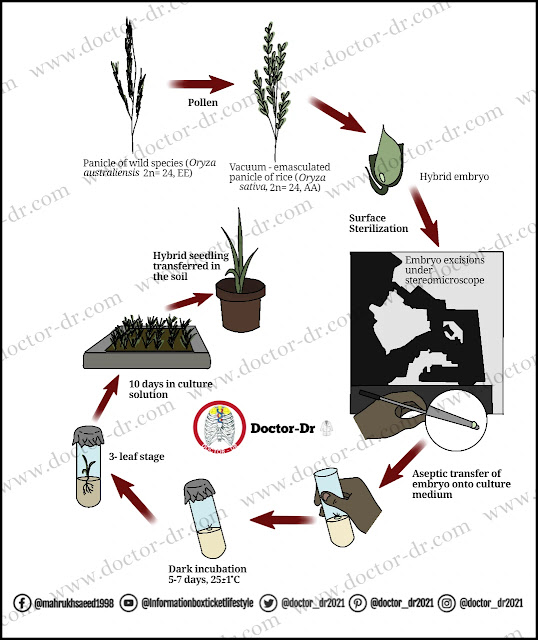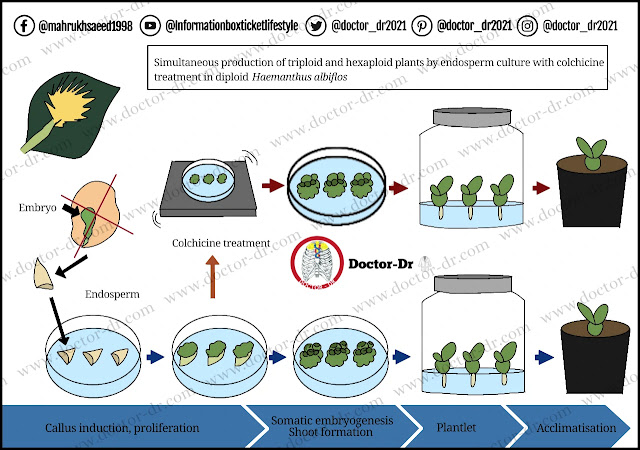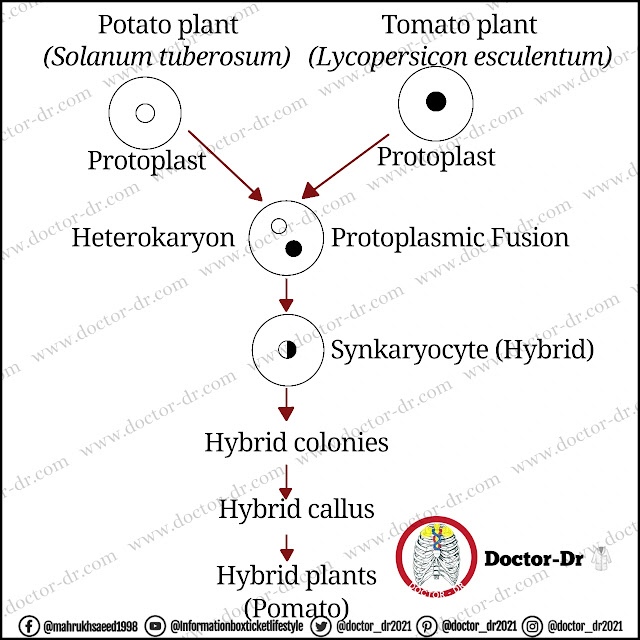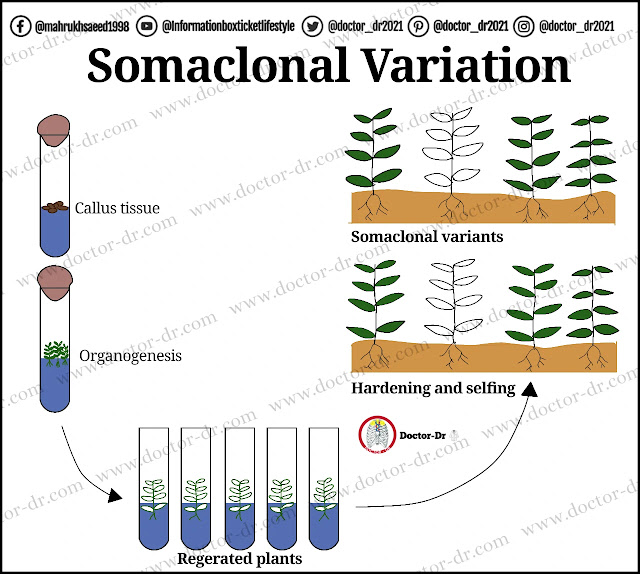Plant tissue culture has various applications, such as:
2. Virus free plants formation
8. Plant secondary metabolite formation
10. In-vitro germplasm conservation
1. Micropropagation
- The plant parts usually used for this type of propagation are apical meristem or auxiliary buds or the seedlings obtained by the in vitro germination of seeds.
- Since this method of micropropagation is rapid and convenient for generating a large number of genetically-identical plantlets it has been used commercially for the mass multiplication of crop plants such as cardamom, apples, eucalyptus, bananas, and many other ornamental and horticultural plants.
2. Virus-Free Plants
- One of the main purposes of propagation through tissue culture is to produce virusfree plants.
- This is very important to increase yield and quality.
- Agricultural plants, which have a high risk of damage due to viral diseases include plants such as bananas, sugarcane, potatoes, apples, etc.
- Since meristems such as apical meristem and auxiliary meristem are free from viral infections these tissues can be used as explants for mass multiplication to get a large number of virus-free plants.
- Tissue culture using meristem is sometimes referred to as ‘meristem culture’ and the plantlets produced are known as ‘mericlones’.
3. Artificial Seeds
- Artificial seeds are the somatic embryos encapsulated by certain inert polymeric compounds such as alginate.
- They are also very useful in the mass propagation of agricultural and hybrid varieties.
4. Embryo Rescue
- Tissue culture also provides the means to overcome reproductive barriers between distantly related wild relatives of crops through embryo rescue and in vitro fertilization.
- It is very difficult to produce hybrid plants by interspecific crosses.
- Such hybridizations can result in abnormal endosperm, which causes premature death of embryos resulting in the formation of sterile seeds.
- The embryo from such hybrid plants can be excised and cultured on a suitable nutrient to produce new hybrids.
- This method of protecting the embryo viability and its development in vitro is called embryo rescue.
5. Haploids and Triploids
- The culture of immature anthers and pollen grains is done to induce the pollen grains to develop into multicellular embryos, with half the normal number of chromosomes for the species (haploids).
- When such haploid embryos are treated with chromosome-doubling agents (e.g., colchicine) their normal chromosome number is restored.
- Thus, it is a very easy method for the development of homozygous genotypes or pure lines.
- The generation of pure lines and haploids is very helpful for analyzing the expression of recessive characteristics, which cannot be expressed in heterozygous conditions.
- Triploids are raised by culturing endosperm tissues and are useful in generating triploid plants, which are sterile.
- it is very useful for creating seedless plants that are desirable in fruit crops such as grapes, citrus fruits, apples, pears, etc.
6. Somatic Hybrids
- Somatic hybrids are the hybrid plants developed from the fusion of two somatic cells.
- The hybrid protoplasts can be selected visually and cultured separately to develop into a callus and then differentiated into a complete plant.
- This type of hybridization of distantly-related plants through sexual fertilization is never possible in nature.
- Somatic hybridization is also known as parasexual hybridization.
- The fusion of isolated protoplasts can be carried out with chemical agents such as PEG (polyethylene glycol) or by electrical force, a method called electrofusion.
- Carlson and his group produced the first somatic hybrid of two different species Nicotiana glauca and Nicotiana langsdorfii in 1972.
- In 1978, Melchers et al developed for the first time a hybrid between plants of two different genus— Solanum tuberosum (potato) and Lycopersicon esculentum (tomato).
- The somatic hybrid thus developed was named ‘pomatoes’ or ‘topatoes.
7. Cybrids
- Fusion of a enucleated and nucleated protoplasts can result in a special type of somatic hybrids known as cybrids.
- Cybrids can be used to transfer male sterility (through mitochondrial genome) or herbicides resistance (through chloroplast genome) characters through cytoplasmically inherited process.
- For example, cytoplasm male sterile character has been successfully transferred from N. tobaccum to N. sylvestris and from N. campestris to Brassica napus after protoplast fusion.
8. Plant Secondary Metabolites
- Plants are the source of a large number of chemicals.
- Plant-derived chemicals can be divided mainly into two classes—primary metabolites and secondary metabolites.
- Chemicals such as proteins, amino acids, sugars, lipids, nucleic acids, and their derivatives essential for the basic metabolic activities are called primary metabolites.
- Secondary metabolites are certain chemicals that are formed as by-products of the primary metabolites such as alkaloids, flavanoids, tannins, terpins, essential oils, latex, etc.
- Plant secondary metabolites have a large number of uses as medicines, flavoring compounds, fragrances, natural rubber, sources of hydrocarbons, biofuels, etc.
- The extensive use of plants as the sources of these compounds has brought them to the verge of extinction.
- In this way plant tissue and cell cultures provide an alternate source for plant secondary metabolites.
- The plant-cell cultures are a potential means of producing useful plant secondary products without depending on the large-scale cultivation of source plants.
- Mitsui Petrochemical Industry Co. Ltd., in Japan, in producing shikonin on a commercial scale from Lithospermum erythrorhizon cultivations.
- Nitto Denko Co. Ltd., also in Japan, is producing Ginseng cells using 20 kL tanks.
9. Somaclonal Variation
- The advantage of micropropagation for mass multiplication of a plant species is that it can provide a large number of genetically-identical plants in large numbers.
- But it has been observed that it is not true in the case of plants which are regenerated from the callus cultures maintained for very long periods and also from cell suspension cultures.
- Such plants show variations and such variations observed during these asexual means of propagation are called somaclonal variations.
- The term somaclones was proposed by Larkin and Scowcroft in 1981, for the plants that were produced from a tissue isolated from a plant variety and the variation observed among the somaclones was termed somaclonal variation.
- The somaclonal variations have potential applications in agriculture and crop improvement by producing somaclonal mutants with desirable characters.
10. In Vitro Plant Germplasm Conservation
- Tissue-culture methods are used for the conservation of plant varieties for future studies and plant-breeding purposes.
- Because of the extensive use of modern agricultural varieties and hybrids, primitive crops and their wild relatives are on the path to extinction.
- The best method of protecting them and to prevent the erosion of plant genetic resources is to conserve them through tissue culture.
- Collection and conservation of any plant parts or tissue through tissue culture is done in in vitro gene banks.
- Germplasm conservation can be carried out by collecting and preserving genetic resources by conventional methods in the form of seeds, vegetative propagules, etc.
- The conventional method of germplasm conservation has several limitations.
- Germplasm cannot be conserved for a very long time.
- The seeds are short lived and have demerits of seed dormancy, seed-borne diseases, and germplasm needs high input of labor, space, and cost.
- The in vitro approaches through cell and tissue-culture can overcome many of these inconveniences and problems, with the following tissue-culture-mediated conservation methods:
- Cryopreservation
- Cold Storage
1. Cryopreservation
- It is a long-term preservation of selected cells and tissues at very low temperature, equal to the temperature of liquid nitrogen (– 196°C).
- The tissues can be stored at this temperature indefinitely with the help of cryoprotectants such as glycerol, mannitol, dimethylsulfoxide, proline, etc.
- Cryopreservation has proved to be an efficient conservation method for the longterm storage of genetic stocks without any loss of viability and mutations.
2. Cold Storage
- This method of storage of plant parts and tissues for conservation is suited for short term.
- The germplasm can be stored in the form of meristems such as shoot tips or auxiliary buds or other similar parts under low temperatures ranging from 4 to 15°C under nutrient limitations.









%20Technique%20A%20Comprehensive%20Guide%20to%20Water%20Quality%20Testing%20and%20Microbiological%20Analysis.webp)

.webp)
~1.webp)


